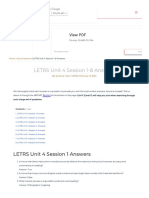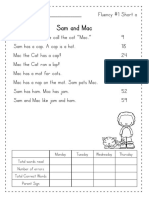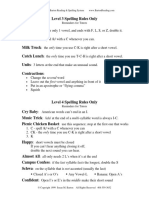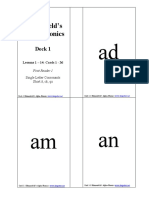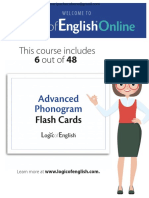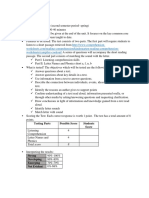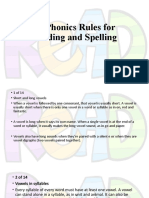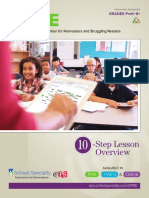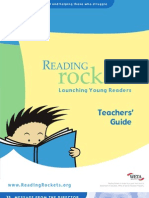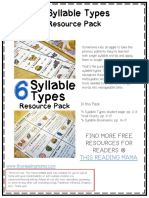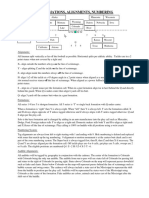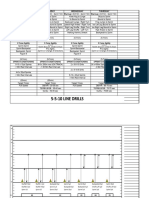LETRS Unit 1 Assessment Answers Quizzma
Uploaded by
coachaddison93LETRS Unit 1 Assessment Answers Quizzma
Uploaded by
coachaddison93Quizzma
Free online quizzes and answers
View PDF
File size: 12.6MB. OS: Win
free-pdf-pro.com Open
Home » Quiz Answers » LETRS Unit 1 Assessment Answers
LETRS Unit 1 Assessment Answers
By Quizzma Team / LETRS
We thoroughly check each answer to a question to provide you with the most correct answers. Found a mistake? Tell us
about it through the REPORT button at the bottom of the page. Ctrl+F (Cmd+F) will help you a lot when searching
through such a large set of questions.
FIND YOURS
Contents [ hide ]
1 Questions To Learn
2 How Many Questions Are On The LETRS Unit 1 Assessment?
3 Sources
4 LETRS Assessment Answers
b. The Three Cueing Systems model omits or obscures the
role of phonology. What is one important distinction between the
Four-Part Processing Model for Word Recognition
and the Three Cueing Systems model? a. The Four-
Part Processing Model emphasizes visual processes.
b. The Three Cueing Systems model omits or
obscures the role of phonology. c. The Three Cueing
Systems model emphasizes the role of phonology. d.
The Three Cueing Systems model omits semantic
processing.
d. both foundational reading skills and oral language
development Many students at risk for reading problems enter
school without exposure to the academic language
used in books or preschool experience. These
students are most likely to make progress closing
the reading and language gap if their classroom
instruction emphasizes which of the following? a.
oral language comprehension and reading aloud b.
attending to context, including semantic and
syntactic cues c. matching students with interesting
reading material d. both foundational reading skills
and oral language development
a. early alphabetic
A beginning first-grade student is able to segment
and pronounce the first sound in a spoken word. He
tries to guess at words by looking at the first letter
only. When he writes words, he spells a few sounds
phonetically, but not all the sounds. According to
Ehri, this student is most likely in which phase of
word-reading development? a. early alphabetic b.
later alphabetic c. prealphabetic d. consolidated
alphabetic
b. phonology
A kindergarten teacher is having students listen to
three spoken words and identify the two words that
end with the same sound. The teacher is focusing on
which language system? a. morphology b.
phonology c. orthography d. semantics
d. Determine if the students need remediation in word
recognition, language comprehension, or both. Considering the Simple View of Reading, what
would be the BEST course of action for a third-grade
teacher with concerns about several students who
have not achieved fluency? a. Observe whether
students are able to work on several subskills at
once. b. Verify that students have been engaged in
independent reading at home for 20 minutes every
day. c. Increase demand on students to improve
their passage reading rate. d. Determine if the
students need remediation in word recognition,
language comprehension, or both.
a. primary difficulties with phonology, decoding, and word
recognition In any first-grade classroom in a typical school in the
United States, approximately one-third of students
are likely to score in the “basic” or “below basic”
range. The largest proportion of those students is
likely to show which characteristics? a. primary
difficulties with phonology, decoding, and word
recognition b. primary difficulties with phonology
only c. primary difficulties with automatic word
recognition only d. primary difficulties with
language comprehension only
b. Reading problems can be treated as easily in third grade
as in first grade. Which of the following statements is FALSE with
regard to an effective implementation of a multi-
tiered system of supports (MTSS)? a. It is possible for
95 percent of kindergarten students to meet
benchmark by the end of the year. b. Reading
problems can be treated as easily in third grade as in
first grade. c. Progress-monitoring assessments
should be brief, curriculum based, and economical.
d. Students can learn to read even if there is little
help available at home.
b. both regular and irregular words
. One important goal of beginning reading
instruction is the development of a sight vocabulary
that enables the student to recognize a word
instantly, without having to decode it. What types of
words should make up a student’s sight word
vocabulary? a. phonetically irregular words b. both
regular and irregular words c. phonetically regular
words d. high-frequency words
b. They can predict which students are at long-term risk for
reading failure. What is the value of data provided by screening
measures? a. They can demonstrate the reliability of
test results on repeated administrations. b. They can
predict which students are at long-term risk for
reading failure. c. They can determine which
students need a referral to special education. d. They
can contribute to teacher evaluations.
b. It is morphophonemic.
In comparison to other alphabetic languages,
what feature of the English writing system makes
English more difficult for young students to read and
spell? a. It is syllabic. b. It is morphophonemic. c. It is
a shallow orthography. d. It is phonetically
transparent.
b. semantics
A second-grade teacher, in preparation for reading a
new text about honeybees, asks the students to
brainstorm all the meanings they know for the word
comb. The teacher is primarily focusing on which
language system? a. phonology b. semantics c.
orthography d. morphology
c. Skilled readers perceive all letters when they read.
Experiments that use modern eye-movement
technology to investigate what the eye “sees” when
a proficient reader scans and comprehends a text
have made what important discovery? a. Good
readers skim a text, perceiving just a few letters. b.
Good readers are dependent on context to identify
words. c. Skilled readers perceive all letters when
they read. d. The perceptual span of a good reader is
triple that of a poor reader.
Questions To Learn
Which statement best describes the relationship between
reading comprehension and word decoding in a beginning Accurate, fast word recognition is necessary for
reader’s development? development of reading fluency and text
comprehension.
Near the close of the day, a kindergarten teacher guides the
students in conversation about the day’s activities. She phonological awareness
writes down what is said on large chart paper, then reads it
to the class. This activity would aid their literacy
development primarily by promoting which skill?
What is the most important implication of the Four-Part
Processiong Model for Word Recognition? Reading depends on constructing pathways
between the phonological, orthographic, and
meaning processors.
After results of a winter screening, six second-graders
scored in the “somewhat at risk” range. What is the next Analyze the screening results and gather additional
step the teacher team should take? diagnostic assessment data.
How is the word sn-ow divided?
onset – rime
How many spoken syllables are there in frightening?
Three
How many spoken syllables are there in cleaned?
Two
What is the main reason that the ability to identify,
segment, blend, and manipulate individual phonemes in Each letter in a word represents an individual
spoken words is important for reading an alphabetic writing phoneme
system?
Students with relative weaknesses in basic phonemic
awareness are most likely to make progress if the teacher asks students to look into a mirror while they
provides which practice? describe the way that target phonemes are formed
in the mouth
Which student is demonstrating the most advanced level of
phonemic awareness? the student substituting a sound in a given word
and saying the new word
A student spells skin as sgin. What type of phonological
error did she make? substitution of a voiced for an unvoiced consonant
Having students listen to a word, say it, and then mentally
reverse the sounds in the word is an instructional activity those who have mastered basic phonemic
that would be most appropriate for which students? awareness
How can phonics instruction be organized to be most
effective? around a preplanned progression through a logical
scope and sequence
Which word group might a teacher include in a lesson
focused on identification of consonant blends? plan, squirm, train
Which word group might a teacher include in a lesson
focused on reviewing consonant digraphs? phone, throne, shown
In the early alphabetic phase of word-reading development,
students know some letter-sound correspondences and blending 2-3 phoneme-grapheme correspondences
most letter names. A student at this level is most likely to within simple, one-syllable words
progress with what type of instruction?
Many screening measures can be considered diagnostic
since they provide extremely detailed data about a students true or false
skills in particular literacy domains.
If a student needs work on phonics and decoding, what
kind of informal diagnostic assessment would provide the a. a spelling inventory to show which features of
most useful information on how to help this student with English spelling the student has mastered b. a
these skills? word-reading survey to show which sound-symbol
correspondences the student knows and which
ones still need practice c. a vocabulary test to show
student understanding of word meanings in context
d. a test of reading comprehension to show how
well the student can answer questions about a
grade-level text
Which of the following is not an area of inquiry to include in
a comprehensive diagnostic assessment of a potential a. spelling b. handwriting c. single-word decoding d.
reading disorder? social interactions
Which of these literacy skills have students typically
mastered by the end of third grade? Select all that apply. a. advanced phonemic awareness b. Greek-derived
morphemes c. inflectional morphology d. fluent
recognition of word families (rime patterns)
Cody is in first grade. He almost never raises his hand to
participate in class discussions. When called on, he replies a. administering a phonics survey b. reading a story
very briefly. He tends to use vague words like stuff and rarely to him and having him orally retell it c. examining
uses full sentences. During decoding exercises, he reads
words accurately and easily recognizes common patterns; samples of his writing d. administering a timed oral
he is a good speller. When he reads stories aloud, he reads reading fluency assessment
fairly accurately but in an expressionless monotone. Which
assessment would be most likely to yield valuable
information about Cody?
Large-scale studies have show that about half of first-
graders who struggle with reading will catch up by third False
grade without any special interventions.
What is the primary purpose of progress-monitoring
assessments? They help teachers determine if a particular
instructional approach is working to bring a student
closer to a target level of reading skill.
Which characteristics describe typical outcome
assessments? Select all that apply. a. designed to measure passage comprehension c.
useful for comparing individuals to norms for a
given age or grade level
Which is a common limitation of screening measures?
The imprecision of the measures results in false
positives- children identified as lacking sufficient
reading skills even though they will later develop
adequate reading skills.
For an assessment to be useful in a school setting, which
three psychometric criteria are the most important? reliable, valid, efficient
A student with dyslexia may also be intellectually gifted
true
Students who are slow at word reading and text reading,
but can segment and blend sounds orally, typically have True
better outcomes than students with phonological
processing deficits.
Dyslexic is a term often applied to a large subset of poor
readers. These readers’ difficulties with accurate, fluent word phonological processing
recognition originate primarily with deficits in which of the
following?
Which of the following can pose challenges for readers who
are English Learners (ELs)? Select all that apply. a. Compared to native English speakers, ELs have
fewer English words in their phonological lexicons b.
ELs may encounter passages that do not align well
with their culture and background knowledge. d.
When they read, ELs must perform two tasks at
once: deciphering words and translating content
between English and their first language.
About 10-15 percent of poor readers can decode and read
individual words quickly and well and can spell accurately- autism and autism spectrum disorders
yet struggle to comprehend the meanings of passages. This
profile is typical of students with which coexisting disorder?
What skill is most important for a student just learning to
read? accurate decoding
Why is it important to build students’ fast and accurate
word recognition and spelling? so that students don’t have to laboriously sound out
words
Which scenario describes a child in the prealphabetic
phase? a child who responds “Meow!” when asked, ” What is
the first sound in cat?”
Which scenario describes a child in the consolidated
alphabetic phase? a child who sees the word inactive and figures out
that it means “not active”
The primary are of difficulty for students who fall behind in
their reading development is underdeveloped foundational reading skills
A significant shortcoming of the Three-Cueing Systems
model, compared to the Four-Part Processing Model, is that phonological processing
it obscures the role of ______ in word recognition.
Which best describes the activity of the reading brain in
proficient readers, compared to beginning readers? It is more automatic
Which of these does the language-comprehension
component of the Reading Rope emphasize? the importance of vocabulary development and of
understanding language structures
The word-recognition component of the Reading Rope
includes which subskills? Select all that apply a. decoding c. phonological awareness d. sight
recognition
Good readers do not require a large storehouse of sight
words in their memory if they have highly developed false
phonographic skills.
During reading, our eyes process each word letter by letter.
true
How many letters does the eye normally take in at each
fixation point before moving on to the fixation point? 7-9 to the right 3-4 to the left
The four-part processing model helps us understand
__________ how multiple parts of the brain must work together
in order for word recognition to occur
The are known as the visual word form are or “brain’s
letterbox” is located in the _______ lobe and is essential to occipital; orthographic
the ________ processor.
What are some symptoms of children who have trouble
with phonological processing? a. slow to blend sounds in words together c.
difficulty remembering sounds for letters d. trouble
spelling speech sounds for words
Which statement best describes the relative importance of
oral reading fluency and verbal comprehension as factors in As children get older, verbal comprehension
reading comprehension? becomes more important than oral reading fluency
Which o these is an example of morphology
We know the words unique, uniform, united, and
universe all contain the root uni, meaning “one”
Which is a characteristic of discourse in spoken language?
it does not use paragraphs and tends to be
disorganized
How does the language system of pragmatics help us to
understand why written language is mores structured than Social context and nonverbal gestures help the
spoken language? listener understand spoken language, so there is
less need for it to be highly structured
What adds to the challenge of becoming literate? Select all
that apply a. All meaning reside sin the written words alone;
there is no additional physical context or gestures,
facial expressions, etc., to support meaning b.
reading and writing require learning new forms of
language, such as changes to sentence structure,
discourse, and presentation of vocabulary and
semantics
According to the 2015 National Assessment of Educational
Progress, what percentage of fourth-grade students have 64% nationally, with African-American and Hispanic
score “basic” or “below basic” in reading? students making up a disproportionate amount
Reading comprehension is not a single construct. Rather,
the ability to understand what you read relies on multiple background knowledge and vocabulary
components. Once readers become more skilled in word
recognition, which of the following components increase in
their importance?
Which statement most accurately describes how the
human brain has evolved to process spoken and written our brains have evolved to process spoken language
language? much more easily than alphabetic writing
What characteristic makes English a “deep” alphabetic
orthography? Its spelling system represents meaningful parts
(morphemes) as well as sounds
According to the Simple View of Reading model, which is
more important to reading comprehension – word Both are equally important
recognition or language comprehension?
How Many Questions Are On The LETRS Unit 1
Assessment?
Did you know that Unit 1 of the LETRS Assessment contains 10 questions? That’s right – 10 questions divided into sections,
each focusing on different aspects of literacy development.
You might also like
- LETRS Unit 4 Session 1-8 Answers QuizzmaNo ratings yetLETRS Unit 4 Session 1-8 Answers Quizzma9 pages
- Worksheets - Syllables and Affixes - 2nd Edition100% (4)Worksheets - Syllables and Affixes - 2nd Edition230 pages
- Orton-Gillingham Based Programs Scope and Sequence100% (8)Orton-Gillingham Based Programs Scope and Sequence2 pages
- Five Phonological and Phonemic Awareness Activities: Page - 1No ratings yetFive Phonological and Phonemic Awareness Activities: Page - 110 pages
- Letrs Unit 1 Assessment Questions With Correct Answers0% (2)Letrs Unit 1 Assessment Questions With Correct Answers3 pages
- LETRS Unit 4 Participant Handouts - Fillable - 1.15.24No ratings yetLETRS Unit 4 Participant Handouts - Fillable - 1.15.2414 pages
- Pals Sound To Letter Segmentation AssessmentNo ratings yetPals Sound To Letter Segmentation Assessment24 pages
- Elkonin Boxes: Full Pages Half Pages 3, 4, & 5 Boxes100% (1)Elkonin Boxes: Full Pages Half Pages 3, 4, & 5 Boxes10 pages
- Phonological Phonemic Awareness Continuum OVERVIEW Clever Classroom PDF50% (2)Phonological Phonemic Awareness Continuum OVERVIEW Clever Classroom PDF8 pages
- 14 Phonics Rules For Reading and SpellingNo ratings yet14 Phonics Rules For Reading and Spelling15 pages
- Teaching Morphology To Increase LiteracyNo ratings yetTeaching Morphology To Increase Literacy10 pages
- Phonemic Awareness Intervention Screening-Grades 2 or Above100% (2)Phonemic Awareness Intervention Screening-Grades 2 or Above10 pages
- Frysightwordassessmentandprogressmonitoringmaterials100% (1)Frysightwordassessmentandprogressmonitoringmaterials18 pages
- STEP 1: Establishing The Range in Student Ability Phonic Sight Word Sequence Placement Test Instructions100% (1)STEP 1: Establishing The Range in Student Ability Phonic Sight Word Sequence Placement Test Instructions13 pages
- Slide-Lesson 27-Open & Closed Syllable, Split SyllableNo ratings yetSlide-Lesson 27-Open & Closed Syllable, Split Syllable51 pages
- Explicit Phonics Mini Lesson CST November 2016100% (1)Explicit Phonics Mini Lesson CST November 201635 pages
- Practice Blending CVC Words by Letting Kids Make Their Own Words. Great Engagement and Accountability100% (2)Practice Blending CVC Words by Letting Kids Make Their Own Words. Great Engagement and Accountability6 pages






